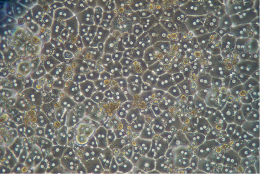What is an integrated hepatic model and why is it important?
An integrated in vitro model maintains physiologic cellular components and processes at in vivo-relevant amounts. In the sandwich-cultured hepatocyte model, relevant drug transporter proteins (uptake and efflux), as well as drug metabolizing enzymes (Phase I and II), are expressed, maintained, and functioning together in the same system. The figure below graphically represents this concept (picture from Qualyst Transporter Solutions).
To obtain a true in vivo understanding of hepatic disposition and drug interactions, all three major clearance pathways (uptake, metabolism, and efflux) must be present, ideally, within the same model system. A system that integrates these three pathways together can assess cellular compensation effects, which mirrors the in vivo situation. In addition, the presence of functional clearance pathways together means that studies to assess induction, hepatotoxicity, cholestasis, clearance, or drug interactions automatically generate physiologic concentrations and metabolites, thereby removing the need to artificially estimate or guess appropriate intracellular concentrations or conditions.
Are cryopreserved hepatocytes suitable?
High quality cells are critical for reliable cell-based assay results. Hepatocytes preparations vary measurably in quality, phenotype, and function, though these differences may not always be visibly evident. Hepatocytes that appear to be the same and express the same level of proteins may not have the same functionality.
 Figure 2: A visual comparison of hepatocytes that are Transporter Certified™ to cells that were found to be unacceptable. Cells were plated, overlaid and cultured under conditions demonstrated to maintain transporter expression, localization and function. All plate sources had similar protein values 0.85±0.04 vs. 0.84±0.08 and visual inspection demonstrated no remarkable differences. However, after certification testing, the unacceptable hepatocytes showed little to no functional activity.
Figure 2: A visual comparison of hepatocytes that are Transporter Certified™ to cells that were found to be unacceptable. Cells were plated, overlaid and cultured under conditions demonstrated to maintain transporter expression, localization and function. All plate sources had similar protein values 0.85±0.04 vs. 0.84±0.08 and visual inspection demonstrated no remarkable differences. However, after certification testing, the unacceptable hepatocytes showed little to no functional activity.
In other words, separate preparations of sandwich-cultured hepatocytes that are cultured for up to 7 days and look identical, may have extremely different functionality. The only way to determine this is to functionally assess these hepatocytes.
Certification process
The certification process involved a multi-point evaluation throughout the plating, overlay, and culture periods. Uptake and efflux function is assessed through an evaluation of total uptake, intracellular concentration, hepatic efflux, overall clearance of substrates for key transporters sited by the FDA and EMA regulatory bodies. Additionally, functional inhibition of the transporters is also characterized. While overall function of the hepatic transporters are important, metabolic activity and bile acid homeostasis are also of key importance in the overall health and performance of Transport Certified™ hepatocytes.
All the performance data for Transporter Certified™ hepatocytes are compared to an extensive historical database to provide relative comparisons to fresh, isolated primary hepatocytes.
Get access to Xenotech Transporter Certified™ hepatocytes here:
- Human Hepatocytes, Qualyst Transporter Certified, Female
- Human Hepatocytes, Qualyst Transporter Certified, Male
Solution for hepatobiliary drug disposition study
The B-CLEAR® technology, from Qualyst Transporter Solutions LLC, refers to a patented methodology that, when applied to Certified Hepatocytes in culture, opens the bile pockets (analogous to bile canaliculi in vivo), allowing the measurement of material that has been transported from inside the cell. Measurement of biliary efflux allows us to exclusively evaluate biliary clearance and biliary transporter interactions, as well as perform cellular mass balance measurements.
 The presence of calcium [Plus (+) Buffer] is required to maintain the integrity of the tight junctions. When the hepatocytes are incubated in buffer lacking calcium [Minus (-) Buffer], the tight junctions open and release the contents of the bile pockets into the media.
The presence of calcium [Plus (+) Buffer] is required to maintain the integrity of the tight junctions. When the hepatocytes are incubated in buffer lacking calcium [Minus (-) Buffer], the tight junctions open and release the contents of the bile pockets into the media.
The B-CLEAR® technology uses the modulation of tight junctions in sandwich-cultured hepatocytes to estimate the biliary clearance of compounds.
The in vitro biliary clearance is estimated by determining the total amount of compound that is taken up and subsequently excreted into the canalicular networks.




